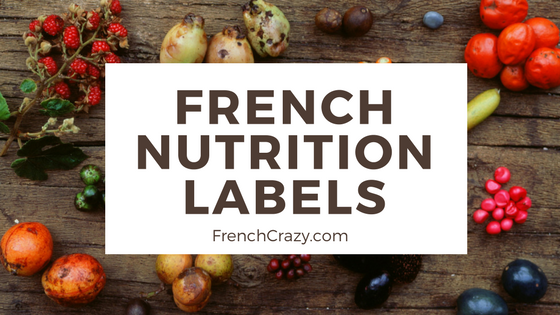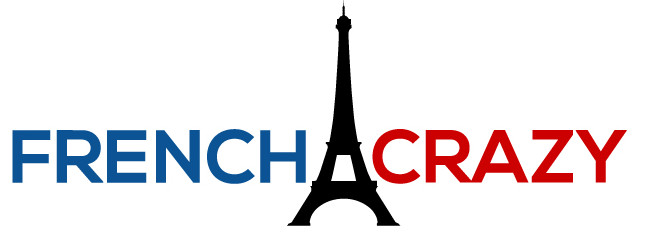So, you travel to France and you wanted to have a piece of chocolate… Mmmm Esprit Noir à la Menthe! You take a gander at “Les Informations Nutritionnelles.”
No surprise, it’s in French. What does 2190KJ pour 100g even mean?
Today we’ll discuss the vocabulary associated with food packaging, nutrition, and basic ingredients in French. Then I’ll explain how to spot allergic information and how the French portion their food.

Common French Nutrition Vocabulary
These are terms that you’ll see on most nutrition labels on French food and I’ve translated what they mean to English:
Valeur énergétique: Calories (energetic value)
Protéines: Protein
Lipides: Fats
Lipides dont acids gras saturés: Saturated Fats
Glucides: Carbohydrates
Glucides dont sucre: Sugar
Fibres allimentaire: Dietary Fiber
Sodium: Salt
Poids Net: Total Weight
Un Portion: A serving
Contient: Contains
Conserver: Store (for example, it’ll say “store” at a certain temperature to avoid spoilage)
RNJ = Repères Nutritionnels Journaliers: Recommended Daily Allowance
Common French Ingredients
Arôme: Flavoring (arôme pomme/cannelle would mean cinnamon-apple flavoring)
Avoine: Oats
Bicarbonate de soude: Baking soda
Blé (complète): Wheat (whole wheat)
Beurre (pâtissier): Butter (concentrated)
Colorant: Artificial coloring
Eau: Water
Farine (de blé complète): Flour (whole wheat flour)
Huile (d’olive, tournesol, végétale): Oil (olive oil, sunflower oil, vegetable oil)
Lait (en poudre, écrémé): Milk (powdered milk, skimmed-milk)
Matière grasse (végétale): Fat, Lard (Vegetable fat)
Noix: Nuts (avoid if you have a nut allergy)
Oeuf: Egg
Sel: Salt
Sirop de glucose: Glucose syrup (corn syrup)
Vinaigre (balsamique, de vin rouge): Vinegar (balsamic…, red wine…)
Luckily some words resemble their English counterparts.
Now, when I read the label of the chocolate, it says that 1 portion (10g) contains 220kJ (55kcal). If you paid attention during chemistry or physics, you would realize that roughly 4.4 kilojoules is equivalent to 1 kilocalorie. One kcal is equal to 1 Calorie. Thus, 55kcals is equal to 55 Calories!
Not bad for a sinful piece of chocolate.
Usually the French packaging will include the nutritional information for one serving and for the entire packet. So when you notice that eating your morning cereal will add 1,995kcals to your belly, you’re probably looking at the wrong side.
Reading French nutrition labels would be annoying if you’re unfamiliar with the metric system. An easy way to estimate what makes a portion is to take the Poids Net, or total weight, and then divide that by the indicated portion size. So, if a box of cereal says a portion is 45 grams and the whole box contains 500 grams, then you would have approximately 11 portions. You can eye out one-eleventh of the container and enjoy your French food accordingly. You could also weigh your cereal on a scale if you’re obsessing about this sort of stuff.
Allergies!?
I just have a little aside for allergic people. A statement that identifies allergies would go something like this: Ce produit contient de la poudre de lait et est fabriqué sur une ligne de production utilisant différents types de noix. That long, daunting French sentence is essentially saying that the product contains powdered milk, and is made in a factory that uses different types of nut products. Reading these sentences become imperative if you are allergic to anything. Obviously, you would avoid this product if you have any sort of nut allergy.
Conclusion
I hope this guide on how to read French nutrition labels was helpful. Please comment below if you need anything, or want to add more vocabulary to my list above. (P.S, have you ever wondered how the French could always eat this stuff and not get fat? Check out my article: The French Paradox).



Hi John/French crazy, my daughter is complaining that French nutrition labels don’t give information about iron, so I happened on your site, which is very helpful.
I want to point out that your ‘nuts’ section for allergies is incomplete. Maybe that’s intentional for space reasons, but “noix” is ONLY walnuts. French doesn’t have a generic term for nuts, you have to list each one that might be an allergen: amandes, noisettes, cacahuètes, and so on. Someone allergic to nuts needs to look for…the individual words. Or I’ve seen ‘fruits secs des arbres’ or something similar on labels.
Best regards,
Thank you for pointing this out Nancy